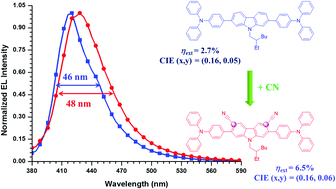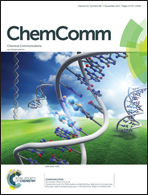A new molecular design based on hybridized local and charge transfer fluorescence for highly efficient (>6%) deep-blue organic light emitting diodes†
Abstract
A deep-blue emitter was developed by modifying carbazole nuclear positions C2 & C7 with a triphenylamine donor and C3 & C6 with a cyano acceptor. The molecular design features cross-conjugated localized and charge transfer chromophores which results in a hybridized local charge transfer (HLCT) excited state. An organic light emitting diode (OLED) using this material exhibited high external quantum efficiency (6.5%) with excellent color saturation (CIEy ∼ 0.06) and small full-width at half maximum (48 nm).



 Please wait while we load your content...
Please wait while we load your content...